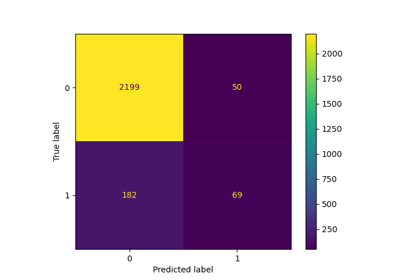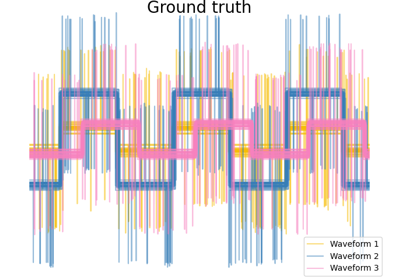pairwise_distances#
- sklearn.metrics.pairwise_distances(X, Y=None, metric='euclidean', *, n_jobs=None, force_all_finite='deprecated', ensure_all_finite=None, **kwds)[source]#
Compute the distance matrix from a vector array X and optional Y.
This method takes either a vector array or a distance matrix, and returns a distance matrix. If the input is a vector array, the distances are computed. If the input is a distances matrix, it is returned instead. If the input is a collection of non-numeric data (e.g. a list of strings or a boolean array), a custom metric must be passed.
This method provides a safe way to take a distance matrix as input, while preserving compatibility with many other algorithms that take a vector array.
If Y is given (default is None), then the returned matrix is the pairwise distance between the arrays from both X and Y.
Valid values for metric are:
From scikit-learn: [‘cityblock’, ‘cosine’, ‘euclidean’, ‘l1’, ‘l2’, ‘manhattan’]. These metrics support sparse matrix inputs. [‘nan_euclidean’] but it does not yet support sparse matrices.
From scipy.spatial.distance: [‘braycurtis’, ‘canberra’, ‘chebyshev’, ‘correlation’, ‘dice’, ‘hamming’, ‘jaccard’, ‘kulsinski’, ‘mahalanobis’, ‘minkowski’, ‘rogerstanimoto’, ‘russellrao’, ‘seuclidean’, ‘sokalmichener’, ‘sokalsneath’, ‘sqeuclidean’, ‘yule’] See the documentation for scipy.spatial.distance for details on these metrics. These metrics do not support sparse matrix inputs.
Note
'kulsinski'is deprecated from SciPy 1.9 and will be removed in SciPy 1.11.Note
'matching'has been removed in SciPy 1.9 (use'hamming'instead).Note that in the case of ‘cityblock’, ‘cosine’ and ‘euclidean’ (which are valid scipy.spatial.distance metrics), the scikit-learn implementation will be used, which is faster and has support for sparse matrices (except for ‘cityblock’). For a verbose description of the metrics from scikit-learn, see
sklearn.metrics.pairwise.distance_metricsfunction.Read more in the User Guide.
- Parameters:
- X{array-like, sparse matrix} of shape (n_samples_X, n_samples_X) or (n_samples_X, n_features)
Array of pairwise distances between samples, or a feature array. The shape of the array should be (n_samples_X, n_samples_X) if metric == “precomputed” and (n_samples_X, n_features) otherwise.
- Y{array-like, sparse matrix} of shape (n_samples_Y, n_features), default=None
An optional second feature array. Only allowed if metric != “precomputed”.
- metricstr or callable, default=’euclidean’
The metric to use when calculating distance between instances in a feature array. If metric is a string, it must be one of the options allowed by scipy.spatial.distance.pdist for its metric parameter, or a metric listed in
pairwise.PAIRWISE_DISTANCE_FUNCTIONS. If metric is “precomputed”, X is assumed to be a distance matrix. Alternatively, if metric is a callable function, it is called on each pair of instances (rows) and the resulting value recorded. The callable should take two arrays from X as input and return a value indicating the distance between them.- n_jobsint, default=None
The number of jobs to use for the computation. This works by breaking down the pairwise matrix into n_jobs even slices and computing them using multithreading.
Nonemeans 1 unless in ajoblib.parallel_backendcontext.-1means using all processors. See Glossary for more details.The “euclidean” and “cosine” metrics rely heavily on BLAS which is already multithreaded. So, increasing
n_jobswould likely cause oversubscription and quickly degrade performance.- force_all_finitebool or ‘allow-nan’, default=True
Whether to raise an error on np.inf, np.nan, pd.NA in array. Ignored for a metric listed in
pairwise.PAIRWISE_DISTANCE_FUNCTIONS. The possibilities are:True: Force all values of array to be finite.
False: accepts np.inf, np.nan, pd.NA in array.
‘allow-nan’: accepts only np.nan and pd.NA values in array. Values cannot be infinite.
Added in version 0.22:
force_all_finiteaccepts the string'allow-nan'.Changed in version 0.23: Accepts
pd.NAand converts it intonp.nan.Deprecated since version 1.6:
force_all_finitewas renamed toensure_all_finiteand will be removed in 1.8.- ensure_all_finitebool or ‘allow-nan’, default=True
Whether to raise an error on np.inf, np.nan, pd.NA in array. Ignored for a metric listed in
pairwise.PAIRWISE_DISTANCE_FUNCTIONS. The possibilities are:True: Force all values of array to be finite.
False: accepts np.inf, np.nan, pd.NA in array.
‘allow-nan’: accepts only np.nan and pd.NA values in array. Values cannot be infinite.
Added in version 1.6:
force_all_finitewas renamed toensure_all_finite.- **kwdsoptional keyword parameters
Any further parameters are passed directly to the distance function. If using a scipy.spatial.distance metric, the parameters are still metric dependent. See the scipy docs for usage examples.
- Returns:
- Dndarray of shape (n_samples_X, n_samples_X) or (n_samples_X, n_samples_Y)
A distance matrix D such that D_{i, j} is the distance between the ith and jth vectors of the given matrix X, if Y is None. If Y is not None, then D_{i, j} is the distance between the ith array from X and the jth array from Y.
See also
pairwise_distances_chunkedPerforms the same calculation as this function, but returns a generator of chunks of the distance matrix, in order to limit memory usage.
sklearn.metrics.pairwise.paired_distancesComputes the distances between corresponding elements of two arrays.
Examples
>>> from sklearn.metrics.pairwise import pairwise_distances >>> X = [[0, 0, 0], [1, 1, 1]] >>> Y = [[1, 0, 0], [1, 1, 0]] >>> pairwise_distances(X, Y, metric='sqeuclidean') array([[1., 2.], [2., 1.]])


